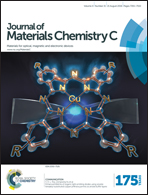The hydrogen-induced structural stability and promising electronic properties of molybdenum and tungsten dinitride nanosheets: a first-principles study†
Abstract
Utilizing first-principles calculations, we have investigated the structural stabilities and electronic properties of MoS2-like MoN2 and WN2 sheets. We find that unlike their disulfide counterparts, these dinitride sheets are dynamically unstable with strong soft modes. The soft modes of dinitride sheets can be eliminated by surface hydrogenation, and the formed MoN2H2 and WN2H2 sheets exhibit good dynamical, thermal and mechanical stabilities for both H and Td phases. It is found that the H-phase structures present a semiconducting behaviour with band gaps of 2.43/2.50 eV for the MoN2H2/WN2H2 sheets. These band gaps can be further modulated by strain engineering, which induces an indirect-direct–indirect band gap transition in the range of −6 to 6%. On the other hand, the Td-phase structures are zero-gap semi-metals, whose Dirac cones locate at off-symmetry reciprocal sites. Distinct from graphene, these Dirac cones are primarily composed of d-orbitals of Mo/W atoms, which are distorted with a notably anisotropic character in the MoN2H2 and WN2H2 systems. Our study demonstrates that transition-metal dinitride nanosheets can be well stabilized by hydrogenation, which brings tunable electronic properties for many potential applications in nano-electronics and nano-devices.


 Please wait while we load your content...
Please wait while we load your content...